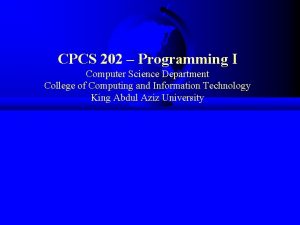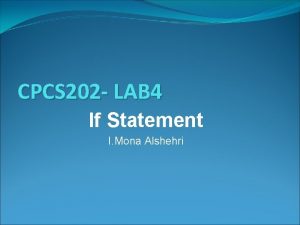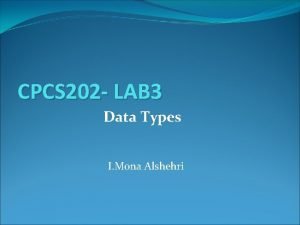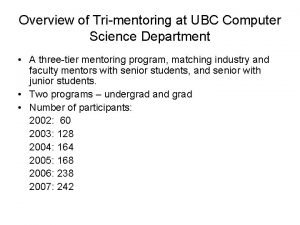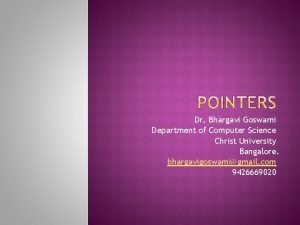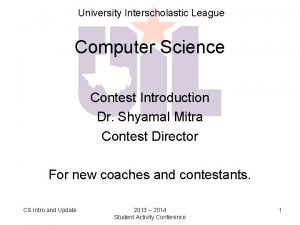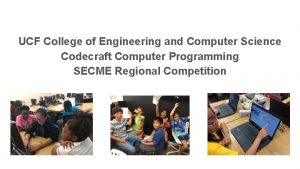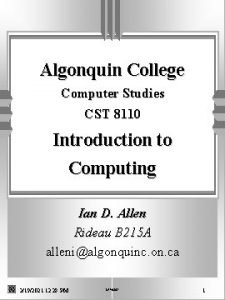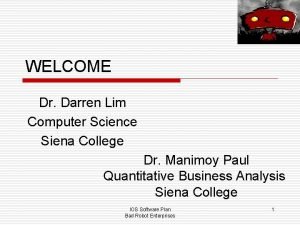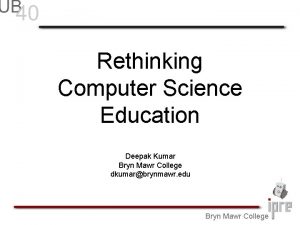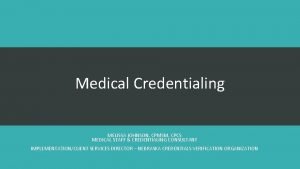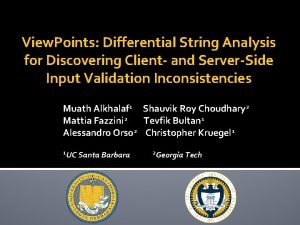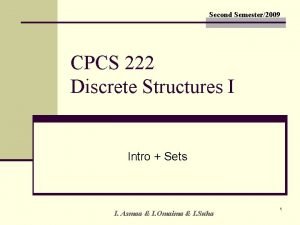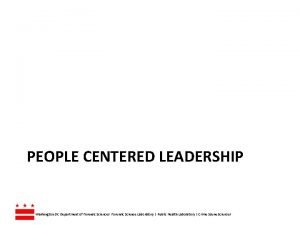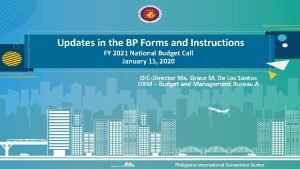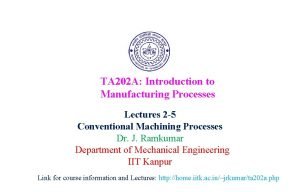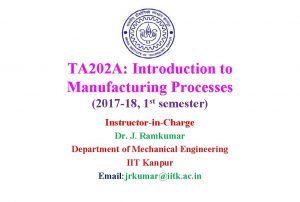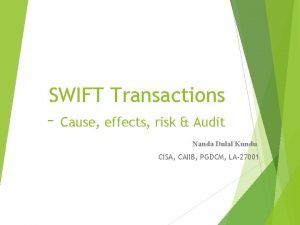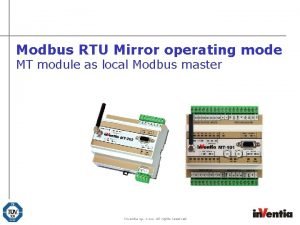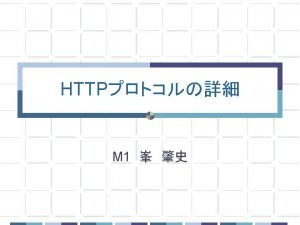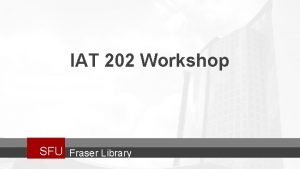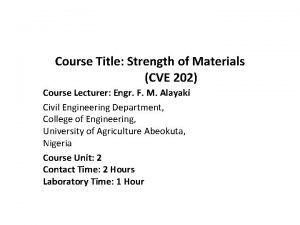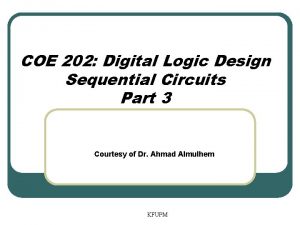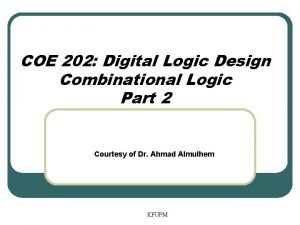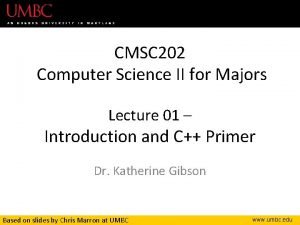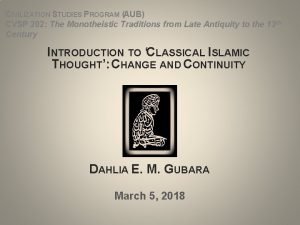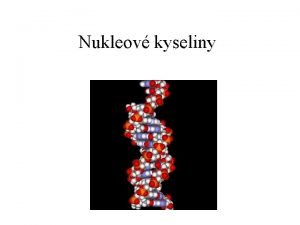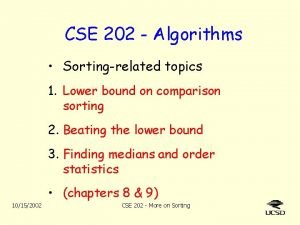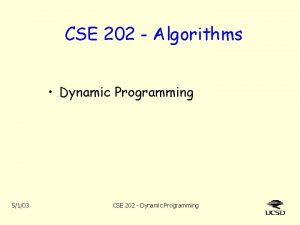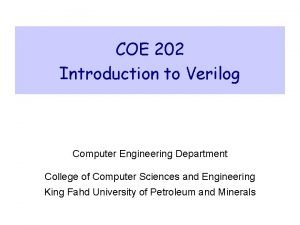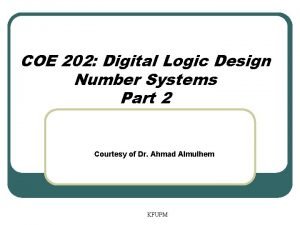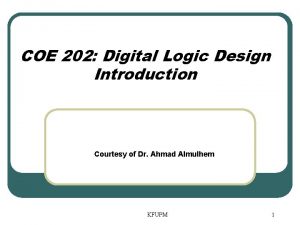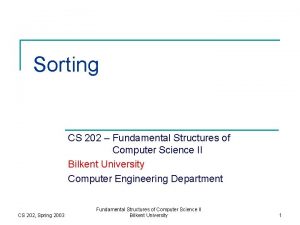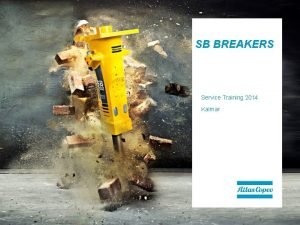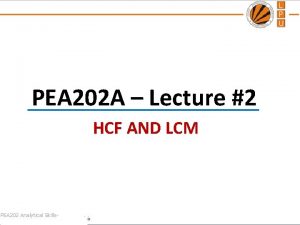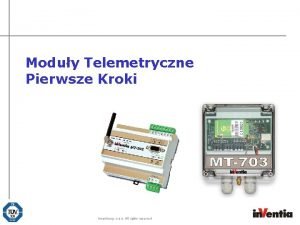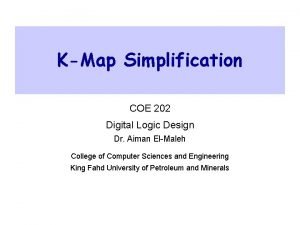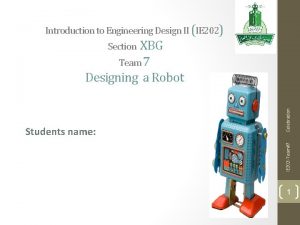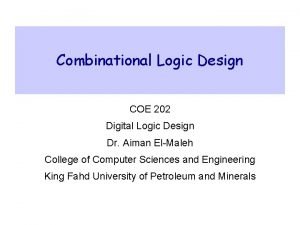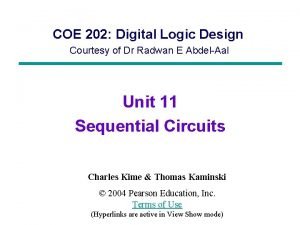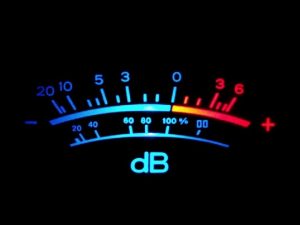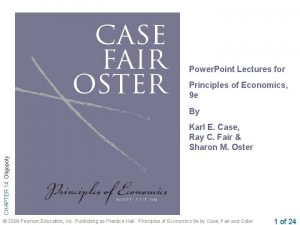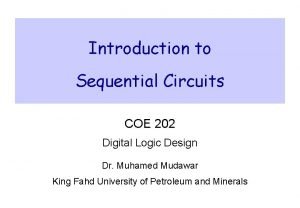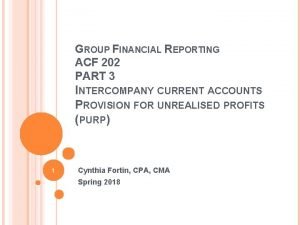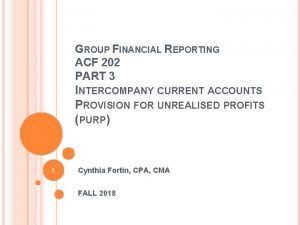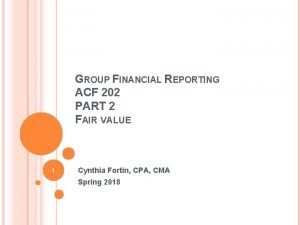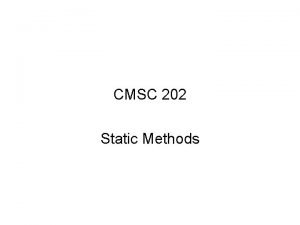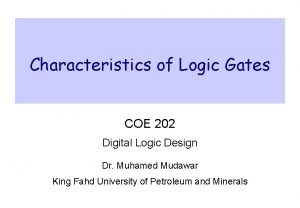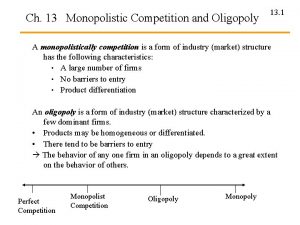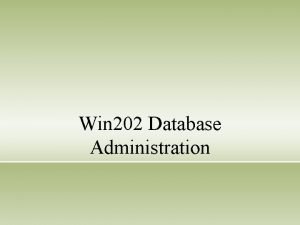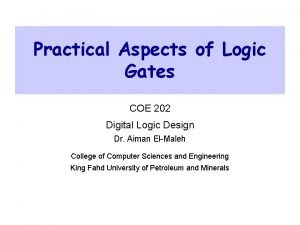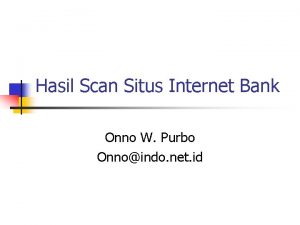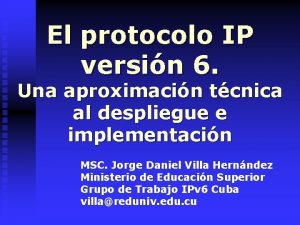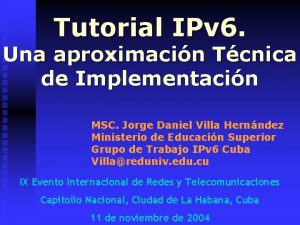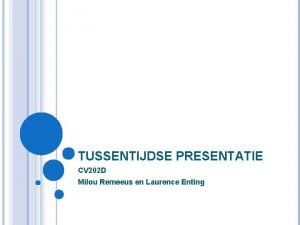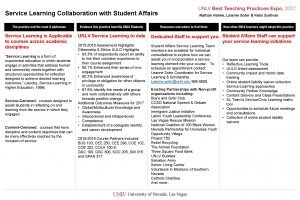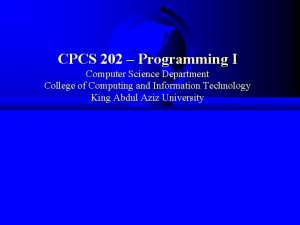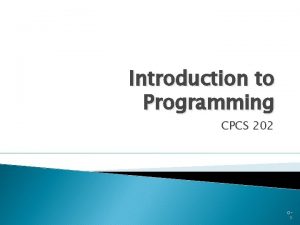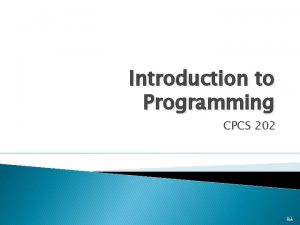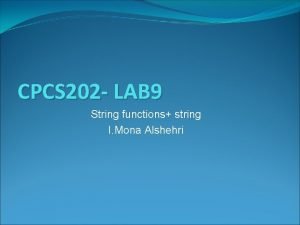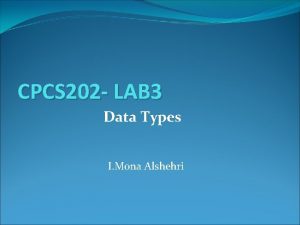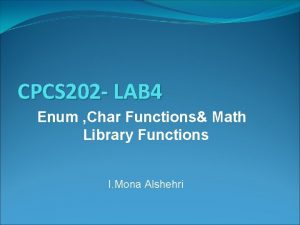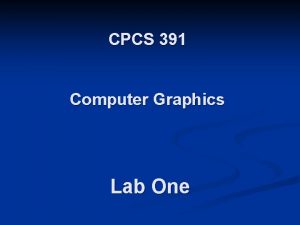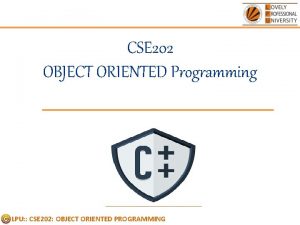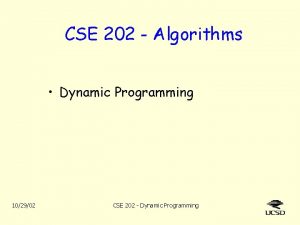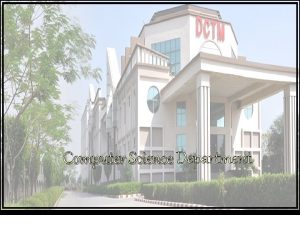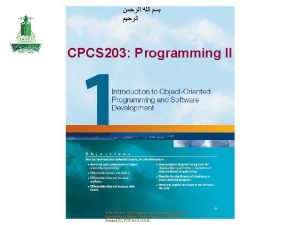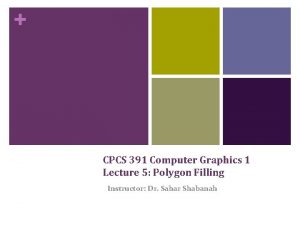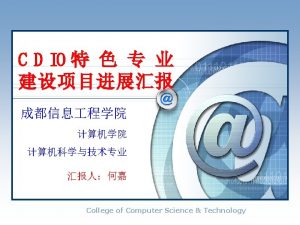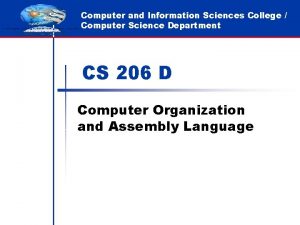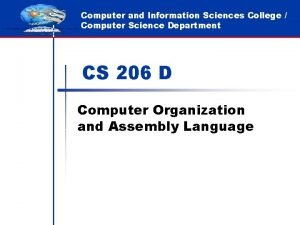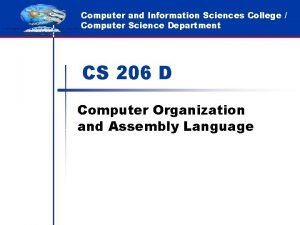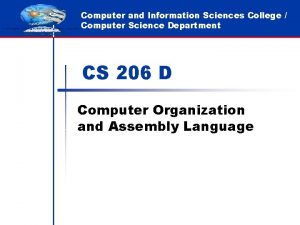CPCS 202 Programming I Computer Science Department College





















































































- Slides: 85

CPCS 202 – Programming I Computer Science Department College of Computing and Information Technology King Abdul Aziz University

Introduction to Java Programming, Comprehensive (8 th Edition), Y. Daniel Liang, Prentice Hall Introduction 1 -

Chapter 1 Introduction to Program Design & Problem-Solving Techniques, Programs, and Java Liang, Introduction to Java Programming, Eighth Edition, (c) 2011 Pearson Education, Inc. All rights reserved. 0132130807 3

Objectives To review Program Design & Problem-Solving Techniques. F To explore the relationship between Java and the World Wide Web (§ 1. 5). F To distinguish the terms API, IDE, and JDK (§ 1. 6). F To write a simple Java program (§ 1. 7). F To display output on the console (§ 1. 7). F To explain the basic syntax of a Java program (§ 1. 7). F To create, compile, and run Java programs (§ 1. 8). F (GUI) To display output using the JOption. Pane output dialog boxes (§ 1. 9). F Liang, Introduction to Java Programming, Eighth Edition, (c) 2011 Pearson Education, Inc. All rights reserved. 0132130807 4

Program Design & Problem-Solving Techniques

How Do We Write a Program? n n A Computer is not intelligent. n It cannot analyze a problem and come up with a solution. n A human (the programmer) must analyze the problem, develop the instructions for solving the problem, and then have the computer carry out the instructions. To write a program for a computer to follow, we must go through a two-phase process: problem solving and implementation. Liang, Introduction to Java Programming, Eighth Edition, (c) 2011 Pearson Education, Inc. All rights reserved. 0132130807 6

Problem-Solving Phase n Analysis and Specification- Understand (define) the problem and what the solution must do. n General Solution (Algorithm)- Specify the required data types and the logical sequences of steps that solve the problem. n Verify- Follow the steps exactly to see if the solution really does solve the problem. Liang, Introduction to Java Programming, Eighth Edition, (c) 2011 Pearson Education, Inc. All rights reserved. 0132130807 7

Implementation Phase n Concrete Solution (Program)- Translate the algorithm (the general solution) into a programming language. n Test- Have the computer follow the instructions. n Then manually check the results. n If you find errors, analyze the program and the algorithm to determine the source of the errors, and then make corrections. n Once a program is tested, it enters into next phase (maintenance). n Maintenance requires Modification of the program to meet changing requirements or to correct any errors that show up while using it. Liang, Introduction to Java Programming, Eighth Edition, (c) 2011 Pearson Education, Inc. All rights reserved. 0132130807 8

Steps in program development

Steps in Program Development 1. Define the problem into three separate components: – inputs – outputs – processing steps to produce required outputs. Liang, Introduction to Java Programming, Eighth Edition, (c) 2011 Pearson Education, Inc. All rights reserved. 0132130807 10

Steps in Program Development 2. Outline the solution. – Decompose the problem to smaller steps. – Establish a solution outline. 3. Develop the outline into an algorithm. – The solution outline is now expanded into an algorithm. Liang, Introduction to Java Programming, Eighth Edition, (c) 2011 Pearson Education, Inc. All rights reserved. 0132130807 11

Steps in Program Development 4. Test the algorithm for correctness. – Very important in the development of a program, but often forgotten – Major logic errors can be detected and corrected at an early stage. 5. Code the algorithm into a specific programming language. Liang, Introduction to Java Programming, Eighth Edition, (c) 2011 Pearson Education, Inc. All rights reserved. 0132130807 12

Steps in Program Development 6. Run the program on the computer. – This step uses a program compiler and programmer-designed test data to machinetest the code for u u 7. syntax errors logic errors Document and maintain the program. Liang, Introduction to Java Programming, Eighth Edition, (c) 2011 Pearson Education, Inc. All rights reserved. 0132130807 13

Algorithms & Flowcharts

n What is an algorithm? ¨ Lists the steps involved in accomplishing a task (like a recipe) ¨ An algorithm must: n Be lucid (clear), precise and unambiguous n Give the correct solution in all cases n Eventually end n What is pseudocode? ¨ Structured English (formalized and abbreviated to look like high-level computer language) Liang, Introduction to Java Programming, Eighth Edition, (c) 2011 Pearson Education, Inc. All rights reserved. 0132130807 15

Pseudocode & Algorithm F Example 1: Write an algorithm to determine a student’s final grade and indicate whether it is passing or failing. The final grade is calculated as the average of four marks. Liang, Introduction to Java Programming, Eighth Edition, (c) 2011 Pearson Education, Inc. All rights reserved. 0132130807 16

Pseudocode & Algorithm Pseudocode: F Input a set of 4 marks F Calculate their average by summing and dividing by 4 F if average is below 50 Print “FAIL” else Print “PASS” Liang, Introduction to Java Programming, Eighth Edition, (c) 2011 Pearson Education, Inc. All rights reserved. 0132130807 17

Pseudocode & Algorithm Detailed Algorithm F Step 1: Input M 1, M 2, M 3, M 4 Step 2: GRADE (M 1+M 2+M 3+M 4)/4 Step 3: if (GRADE < 50) then Print “FAIL” else Print “PASS” endif F Liang, Introduction to Java Programming, Eighth Edition, (c) 2011 Pearson Education, Inc. All rights reserved. 0132130807 18

Flowchart F A graphical representation of the sequence of operations in an information system or program. F Program flowcharts show the sequence of instructions in a single program or subroutine. – shows logic of an algorithm – emphasizes individual steps and their interconnections – e. g. control flow from one action to the next Note: Different symbols are used to draw each type of flowchart. Liang, Introduction to Java Programming, Eighth Edition, (c) 2011 Pearson Education, Inc. All rights reserved. 0132130807 19

Flowchart Symbols Name Symbol Use in Flowchart Oval Denotes the beginning or end of the program Parallelogram Denotes an input operation Rectangle Denotes a process to be carried out e. g. addition , subtraction , division etc. Diamond Denotes a decision (or branch ) to be made. The program should continue along one of two routes. (e. g. IF/THEN/ELSE) Hybrid Denotes an output operation Flow line Denotes the direction of logic flow in the program Liang, Introduction to Java Programming, Eighth Edition, (c) 2011 Pearson Education, Inc. All rights reserved. 0132130807 20

Example 1 F Write an algorithm and draw a flowchart to convert the length in feet to centimeter. Pseudocode: F Input the length in feet (Lft) F Calculate the length in cm (Lcm) by multiplying LFT with 30 F Print length in cm (LCM) Liang, Introduction to Java Programming, Eighth Edition, (c) 2011 Pearson Education, Inc. All rights reserved. 0132130807 21

Example 1 Algorithm F Step 1: Input Lft F Step 2: Lcm Lft x 30 F Step 3: Print Lcm Flowchart START Input Lft Lcm Lft x 30 Print Lcm STOP Liang, Introduction to Java Programming, Eighth Edition, (c) 2011 Pearson Education, Inc. All rights reserved. 0132130807 22

Example 2 Write an algorithm and draw a flowchart that will read the two sides of a rectangle and calculate its area. Pseudocode F Input the width (W) and Length (L) of a rectangle F Calculate the area (A) by multiplying L with W F Print A Liang, Introduction to Java Programming, Eighth Edition, (c) 2011 Pearson Education, Inc. All rights reserved. 0132130807 23

Example 2 Algorithm F Step 1: Input W, L F Step 2: A L x W F Step 3: Print A START Input W, L A Lx. W Print A STOP Liang, Introduction to Java Programming, Eighth Edition, (c) 2011 Pearson Education, Inc. All rights reserved. 0132130807 24

Example 3 F Write an algorithm and draw a flowchart that will calculate the roots of a quadratic equation F Hint: d = sqrt ( ), and the roots are: x 1 = (–b + d)/2 a and x 2 = (–b – d)/2 a Liang, Introduction to Java Programming, Eighth Edition, (c) 2011 Pearson Education, Inc. All rights reserved. 0132130807 25

Example 3 Pseudocode: F Input the coefficients (a, b, c) of the quadratic equation F Calculate d F Calculate x 1 F Calculate x 2 F Print x 1 and x 2 Liang, Introduction to Java Programming, Eighth Edition, (c) 2011 Pearson Education, Inc. All rights reserved. 0132130807 26

Example 3 F Algorithm: F Step 1: Step 2: Step 3: Step 4: Step 5: F F Input a, b, c d sqrt ( ) x 1 (–b + d) / (2 x a) x 2 (–b – d) / (2 x a) Print x 1, x 2 START Input a, b, c d sqrt(b x b – 4 x a x c) x 1 (–b + d) / (2 x a) X 2 (–b – d) / (2 x a) Print x 1 , x 2 STOP Liang, Introduction to Java Programming, Eighth Edition, (c) 2011 Pearson Education, Inc. All rights reserved. 0132130807 27

Decision Structures The expression A>B is a logical expression F it describes a condition we want to test F if A>B is true (if A is greater than B) we take the action on left F print the value of A F if A>B is false (if A is not greater than B) we take the action on right F print the value of B F Liang, Introduction to Java Programming, Eighth Edition, (c) 2011 Pearson Education, Inc. All rights reserved. 0132130807 28

Decision Structures Y Print A is A>B N Print B Liang, Introduction to Java Programming, Eighth Edition, (c) 2011 Pearson Education, Inc. All rights reserved. 0132130807 29

IF–THEN–ELSE STRUCTURE F The structure is as follows If condition then true alternative else false alternative End if Liang, Introduction to Java Programming, Eighth Edition, (c) 2011 Pearson Education, Inc. All rights reserved. 0132130807 30

IF–THEN–ELSE STRUCTURE F The algorithm for the flowchart is as follows: If A>B then print A else print B endif Y Print A N is A>B Print B Liang, Introduction to Java Programming, Eighth Edition, (c) 2011 Pearson Education, Inc. All rights reserved. 0132130807 31

Relational Operators Operator Description > Greater than < Less than = Equal to Greater than or equal to Less than or equal to Not equal to Liang, Introduction to Java Programming, Eighth Edition, (c) 2011 Pearson Education, Inc. All rights reserved. 0132130807 32

Example 4 Write an algorithm that reads two values, determines the largest value and prints the largest value with an identifying message. ALGORITHM Step 1: Input VALUE 1, VALUE 2 Step 2: if (VALUE 1 > VALUE 2) then MAX VALUE 1 else MAX VALUE 2 endif Step 3: Print “The largest value is”, MAX F Liang, Introduction to Java Programming, Eighth Edition, (c) 2011 Pearson Education, Inc. All rights reserved. 0132130807 33

Example 4 START Input VALUE 1, VALUE 2 Y MAX is VALUE 1>VALUE 2 VALUE 1 MAX N VALUE 2 Print “The largest value is”, MAX STOP Liang, Introduction to Java Programming, Eighth Edition, (c) 2011 Pearson Education, Inc. All rights reserved. 0132130807 34

Programming Languages Machine Language Assembly Language High-Level Language Machine language is a set of primitive instructions built into every computer. The instructions are in the form of binary code, so you have to enter binary codes for various instructions. Program with native machine language is a tedious process. Moreover the programs are highly difficult to read and modify. For example, to add two numbers, you might write an instruction in binary like this: 1101101010011010 Liang, Introduction to Java Programming, Eighth Edition, (c) 2011 Pearson Education, Inc. All rights reserved. 0132130807 35

Programming Languages Machine Language Assembly Language High-Level Language Assembly languages were developed to make programming easy. Since the computer cannot understand assembly language, however, a program called assembler is used to convert assembly language programs into machine code. For example, to add two numbers, you might write an instruction in assembly code like this: ADDF 3 R 1, R 2, R 3 Liang, Introduction to Java Programming, Eighth Edition, (c) 2011 Pearson Education, Inc. All rights reserved. 0132130807 36

Programming Languages Machine Language Assembly Language High-Level Language The high-level languages are English-like and easy to learn and program. For example, the following is a high-level language statement that computes the area of a circle with radius 5: area = 5 * 3. 1415; Liang, Introduction to Java Programming, Eighth Edition, (c) 2011 Pearson Education, Inc. All rights reserved. 0132130807 37

Popular High-Level Languages FCOBOL (COmmon Business Oriented Language) FFORTRAN (FORmula TRANslation) FBASIC (Beginner All-purpose Symbolic Instructional Code) FPascal (named for Blaise Pascal) FAda (named for Ada Lovelace) FC (whose developer designed B first) FVisual Basic (Basic-like visual language developed by Microsoft) FDelphi (Pascal-like visual language developed by Borland) FC++ (an object-oriented language, based on C) FC# (a Java-like language developed by Microsoft) FJava (We use it in the book) Liang, Introduction to Java Programming, Eighth Edition, (c) 2011 Pearson Education, Inc. All rights reserved. 0132130807 38

Compiling Source Code A program written in a high-level language is called a source program. Since a computer cannot understand a source program. Program called a compiler is used to translate the source program into a machine language program called an object program. The object program is often then linked with other supporting library code before the object can be executed on the machine. Liang, Introduction to Java Programming, Eighth Edition, (c) 2011 Pearson Education, Inc. All rights reserved. 0132130807 39

Why Java? The answer is that Java enables users to develop and deploy applications on the Internet for servers, desktop computers, and small hand-held devices. The future of computing is being profoundly influenced by the Internet, and Java promises to remain a big part of that future. Java is the Internet programming language. FJava is a general purpose programming language. FJava is the Internet programming language. Liang, Introduction to Java Programming, Eighth Edition, (c) 2011 Pearson Education, Inc. All rights reserved. 0132130807 40

Java, Web, and Beyond F Java can be used to develop Web applications. F Java Applets F Java Web Applications F Java can also be used to develop applications for hand-held devices such as Palm and cell phones Liang, Introduction to Java Programming, Eighth Edition, (c) 2011 Pearson Education, Inc. All rights reserved. 0132130807 41

Examples of Java’s Versatility (Applets) Liang, Introduction to Java Programming, Eighth Edition, (c) 2011 Pearson Education, Inc. All rights reserved. 0132130807 42

PDA and Cell Phone Liang, Introduction to Java Programming, Eighth Edition, (c) 2011 Pearson Education, Inc. All rights reserved. 0132130807 43

Java’s History F James Gosling and Sun Microsystems F Oak F Java, May 20, 1995, Sun World F Hot. Java – The first Java-enabled Web browser F Early History Website: http: //java. sun. com/features/1998/05/birthday. html Liang, Introduction to Java Programming, Eighth Edition, (c) 2011 Pearson Education, Inc. All rights reserved. 0132130807 44

Companion Website Characteristics of Java Is Simple F Java Is Object-Oriented F Java Is Distributed F Java Is Interpreted F Java Is Robust F Java Is Secure F Java Is Architecture-Neutral F Java Is Portable F Java's Performance F Java Is Multithreaded F Java Is Dynamic F www. cs. armstrong. edu/liang/intro 8 e/Java. Characteristics. pdf Liang, Introduction to Java Programming, Eighth Edition, (c) 2011 Pearson Education, Inc. All rights reserved. 0132130807 45

Companion Website F F F Characteristics of Java is partially modeled on C++, but greatly Java Is Simple simplified and improved. Some people refer to Java Is Object-Oriented Java as "C++--" because it is like C++ but with more functionality and fewer negative Java Is Distributed aspects. Java Is Interpreted Java Is Robust Java Is Secure Java Is Architecture-Neutral Java Is Portable Java's Performance Java Is Multithreaded Java Is Dynamic Liang, Introduction to Java Programming, Eighth Edition, (c) 2011 Pearson Education, Inc. All rights reserved. 0132130807 46

Companion Website F F F Characteristics of Java Is Simple Java Is Object-Oriented Java Is Distributed Java Is Interpreted Java Is Robust Java Is Secure Java Is Architecture-Neutral Java Is Portable Java's Performance Java Is Multithreaded Java Is Dynamic Java is inherently object-oriented. Although many object-oriented languages began strictly as procedural languages, Java was designed from the start to be object-oriented. Object-oriented programming (OOP) is a popular programming approach that is replacing traditional procedural programming techniques. One of the central issues in software development is how to reuse code. Objectoriented programming provides great flexibility, modularity, clarity, and reusability through encapsulation, inheritance, and polymorphism. Liang, Introduction to Java Programming, Eighth Edition, (c) 2011 Pearson Education, Inc. All rights reserved. 0132130807 47

Companion Website F F F Characteristics of Java Is Simple Java Is Object-Oriented Java Is Distributed Java Is Interpreted Java Is Robust Java Is Secure Java Is Architecture-Neutral Java Is Portable Java's Performance Java Is Multithreaded Java Is Dynamic Distributed computing involves several computers working together on a network. Java is designed to make distributed computing easy. Since networking capability is inherently integrated into Java, writing network programs is like sending and receiving data to and from a file. Liang, Introduction to Java Programming, Eighth Edition, (c) 2011 Pearson Education, Inc. All rights reserved. 0132130807 48

Companion Website F F F Characteristics of Java Is Simple Java Is Object-Oriented Java Is Distributed Java Is Interpreted Java Is Robust Java Is Secure Java Is Architecture-Neutral Java Is Portable Java's Performance Java Is Multithreaded Java Is Dynamic You need an interpreter to run Java programs. The programs are compiled into the Java Virtual Machine code called bytecode. The bytecode is machineindependent and can run on any machine that has a Java interpreter, which is part of the Java Virtual Machine (JVM). Liang, Introduction to Java Programming, Eighth Edition, (c) 2011 Pearson Education, Inc. All rights reserved. 0132130807 49

Companion Website F F F Characteristics of Java Is Simple Java Is Object-Oriented Java Is Distributed Java Is Interpreted Java Is Robust Java Is Secure Java Is Architecture-Neutral Java Is Portable Java's Performance Java Is Multithreaded Java Is Dynamic Java compilers can detect many problems that would first show up at execution time in other languages. Java has eliminated certain types of errorprone programming constructs found in other languages. Java has a runtime exception-handling feature to provide programming support for robustness. Liang, Introduction to Java Programming, Eighth Edition, (c) 2011 Pearson Education, Inc. All rights reserved. 0132130807 50

Companion Website F F F Characteristics of Java Is Simple Java Is Object-Oriented Java Is Distributed Java Is Interpreted Java implements several security Java Is Robust mechanisms to protect your system against harm caused by stray programs. Java Is Secure Java Is Architecture-Neutral Java Is Portable Java's Performance Java Is Multithreaded Java Is Dynamic Liang, Introduction to Java Programming, Eighth Edition, (c) 2011 Pearson Education, Inc. All rights reserved. 0132130807 51

Companion Website F F F Characteristics of Java Is Simple Java Is Object-Oriented Java Is Distributed Java Is Interpreted Java Is Robust Java Is Secure Java Is Architecture-Neutral Java Is Portable Java's Performance Java Is Multithreaded Java Is Dynamic Write once, run anywhere With a Java Virtual Machine (JVM), you can write one program that will run on any platform. Liang, Introduction to Java Programming, Eighth Edition, (c) 2011 Pearson Education, Inc. All rights reserved. 0132130807 52

Companion Website F F F Characteristics of Java Is Simple Java Is Object-Oriented Java Is Distributed Java Is Interpreted Java Is Robust Java Is Secure Java Is Architecture-Neutral Java Is Portable Because Java is architecture neutral, Java programs are portable. They can be run on Java's Performance any platform without being recompiled. Java Is Multithreaded Java Is Dynamic Liang, Introduction to Java Programming, Eighth Edition, (c) 2011 Pearson Education, Inc. All rights reserved. 0132130807 53

Companion Website F F F Characteristics of Java Is Simple Java Is Object-Oriented Java Is Distributed Java Is Interpreted Java Is Robust Java Is Secure Java Is Architecture-Neutral Java Is Portable Java’s performance Because Java is architecture neutral, Java programs are Java's Performance portable. They can be run on any platform Java Is Multithreaded without being recompiled. Java Is Dynamic Liang, Introduction to Java Programming, Eighth Edition, (c) 2011 Pearson Education, Inc. All rights reserved. 0132130807 54

Companion Website F F F Characteristics of Java Is Simple Java Is Object-Oriented Java Is Distributed Java Is Interpreted Java Is Robust Java Is Secure Java Is Architecture-Neutral Java Is Portable Java's Performance Multithread programming is smoothly Java Is Multithreaded integrated in Java, whereas in other languages you have to call procedures specific to the Java Is Dynamic operating system to enable multithreading. Liang, Introduction to Java Programming, Eighth Edition, (c) 2011 Pearson Education, Inc. All rights reserved. 0132130807 55

Companion Website F F F Characteristics of Java Is Simple Java Is Object-Oriented Java Is Distributed Java Is Interpreted Java Is Robust Java Is Secure Java Is Architecture-Neutral Java Is Portable Java was designed to adapt to an evolving Java's Performance environment. New code can be loaded on the fly Java Is Multithreaded without recompilation. There is no need for developers to create, and for users to install, major Java Is Dynamic new software versions. New features can be incorporated transparently as needed. Liang, Introduction to Java Programming, Eighth Edition, (c) 2011 Pearson Education, Inc. All rights reserved. 0132130807 56

JDK Versions F JDK 1. 02 (1995) F JDK 1. 1 (1996) F JDK 1. 2 (1998) F JDK 1. 3 (2000) F JDK 1. 4 (2002) F JDK 1. 5 (2004) a. k. a. JDK 5 or Java 5 F JDK 1. 6 (2006) a. k. a. JDK 6 or Java 6 F JDK 1. 7 (possibly 2010) a. k. a. JDK 7 or Java 7 Liang, Introduction to Java Programming, Eighth Edition, (c) 2011 Pearson Education, Inc. All rights reserved. 0132130807 57

JDK Editions F Java Standard Edition (J 2 SE) – J 2 SE can be used to develop client-side standalone applications or applets. F Java Enterprise Edition (J 2 EE) – J 2 EE can be used to develop server-side applications such as Java servlets and Java Server. Pages. F Java Micro Edition (J 2 ME). – J 2 ME can be used to develop applications for mobile devices such as cell phones. This book uses J 2 SE to introduce Java programming. Liang, Introduction to Java Programming, Eighth Edition, (c) 2011 Pearson Education, Inc. All rights reserved. 0132130807 58

Popular Java IDEs F Net. Beans Open Source by Sun F Eclipse Open Source by IBM Liang, Introduction to Java Programming, Eighth Edition, (c) 2011 Pearson Education, Inc. All rights reserved. 0132130807 59

A Simple Java Program Listing 1. 1 //This program prints Welcome to Java! public class Welcome { public static void main(String[] args) { System. out. println("Welcome to Java!"); } } Welcome Run IMPORTANT NOTE: (1) To enable the buttons, you must download the entire slide file slide. zip and unzip the files into a directory (e. g. , c: slide). (2) You must have installed JDK and set JDK’s bin directory in your environment path (e. g. , c: Program Filesjavajdk 1. 6. 0_14bin in your environment path. Liang, Introduction to Java Programming, Eighth Edition, (c) 2011 Pearson Education, Inc. All rights reserved. 0132130807 60

Creating and Editing Using Note. Pad To use Note. Pad, type notepad Welcome. java from the DOS prompt. Liang, Introduction to Java Programming, Eighth Edition, (c) 2011 Pearson Education, Inc. All rights reserved. 0132130807 61

Creating and Editing Using Word. Pad To use Word. Pad, type write Welcome. java from the DOS prompt. Liang, Introduction to Java Programming, Eighth Edition, (c) 2011 Pearson Education, Inc. All rights reserved. 0132130807 62

Creating, Compiling, and Running Programs Liang, Introduction to Java Programming, Eighth Edition, (c) 2011 Pearson Education, Inc. All rights reserved. 0132130807 63

Compiling Java Source Code You can port a source program to any machine with appropriate compilers. The source program must be recompiled, however, because the object program can only run on a specific machine. Nowadays computers are networked to work together. Java was designed to run object programs on any platform. With Java, you write the program once, and compile the source program into a special type of object code, known as bytecode. The bytecode can then run on any computer with a Java Virtual Machine, as shown below. Java Virtual Machine is a software that interprets Java bytecode. Liang, Introduction to Java Programming, Eighth Edition, (c) 2011 Pearson Education, Inc. All rights reserved. 0132130807 64

animation Trace a Program Execution Enter main method //This program prints Welcome to Java! public class Welcome { public static void main(String[] args) { System. out. println("Welcome to Java!"); } } Liang, Introduction to Java Programming, Eighth Edition, (c) 2011 Pearson Education, Inc. All rights reserved. 0132130807 65

animation Trace a Program Execution Execute statement //This program prints Welcome to Java! public class Welcome { public static void main(String[] args) { System. out. println("Welcome to Java!"); } } Liang, Introduction to Java Programming, Eighth Edition, (c) 2011 Pearson Education, Inc. All rights reserved. 0132130807 66

animation Trace a Program Execution //This program prints Welcome to Java! public class Welcome { public static void main(String[] args) { System. out. println("Welcome to Java!"); } } print a message to the console Liang, Introduction to Java Programming, Eighth Edition, (c) 2011 Pearson Education, Inc. All rights reserved. 0132130807 67

Two More Simple Examples Welcome 1 Run Compute. Expression Run Liang, Introduction to Java Programming, Eighth Edition, (c) 2011 Pearson Education, Inc. All rights reserved. 0132130807 68

Companion Website Supplements on the Companion Website F See Supplement I. B for installing and configuring JDK F See Supplement I. C for compiling and running Java from the command window for details www. cs. armstrong. edu/liang/intro 8 e Liang, Introduction to Java Programming, Eighth Edition, (c) 2011 Pearson Education, Inc. All rights reserved. 0132130807 69

Companion Website Compiling and Running Java from the Command Window F Set path to JDK bin directory – set path=c: Program Filesjavajdk 1. 6. 0bin F Set classpath to include the current directory – set classpath=. F Compile – javac Welcome. java F Run – java Welcome Liang, Introduction to Java Programming, Eighth Edition, (c) 2011 Pearson Education, Inc. All rights reserved. 0132130807 70

Compiling and Running Java Companion Website from Text. Pad F See Supplement II. A on the Website for details Liang, Introduction to Java Programming, Eighth Edition, (c) 2011 Pearson Education, Inc. All rights reserved. 0132130807 71

Companion Website Compiling and Running Java from JBuilder F See Supplement II. H on the Website for details Liang, Introduction to Java Programming, Eighth Edition, (c) 2011 Pearson Education, Inc. All rights reserved. 0132130807 72

Companion Website Compiling and Running Java from Net. Beans F See Supplement I. D on the Website for details Liang, Introduction to Java Programming, Eighth Edition, (c) 2011 Pearson Education, Inc. All rights reserved. 0132130807 73

Anatomy of a Java Program F Comments F Reserved words F Modifiers F Statements F Blocks F Classes F Methods F The main method Liang, Introduction to Java Programming, Eighth Edition, (c) 2011 Pearson Education, Inc. All rights reserved. 0132130807 74

Comments Three types of comments in Java. Line comment: A line comment is preceded by two slashes (//) in a line. Paragraph comment: A paragraph comment is enclosed between /* and */ in one or multiple lines. javadoc comment: javadoc comments begin with /** and end with */. They are used for documenting classes, data, and methods. They can be extracted into an HTML file using JDK's javadoc command. Liang, Introduction to Java Programming, Eighth Edition, (c) 2011 Pearson Education, Inc. All rights reserved. 0132130807 75

Reserved Words Reserved words or keywords are words that have a specific meaning to the compiler and cannot be used for other purposes in the program. For example, when the compiler sees the word class, it understands that the word after class is the name for the class. Other reserved words in Listing 1. 1 are public, static, and void. Their use will be introduced later in the book. Liang, Introduction to Java Programming, Eighth Edition, (c) 2011 Pearson Education, Inc. All rights reserved. 0132130807 76

Modifiers Java uses certain reserved words called modifiers that specify the properties of the data, methods, and classes and how they can be used. Examples of modifiers are public and static. Other modifiers are private, final, abstract, and protected. A public datum, method, or class can be accessed by other programs. A private datum or method cannot be accessed by other programs. Modifiers are discussed in Chapter 6, “Objects and Classes. ” Liang, Introduction to Java Programming, Eighth Edition, (c) 2011 Pearson Education, Inc. All rights reserved. 0132130807 77

Statements A statement represents an action or a sequence of actions. The statement System. out. println("Welcome to Java!") in the program in Listing 1. 1 is a statement to display the greeting "Welcome to Java!" Every statement in Java ends with a semicolon (; ). Liang, Introduction to Java Programming, Eighth Edition, (c) 2011 Pearson Education, Inc. All rights reserved. 0132130807 78

Blocks A pair of braces in a program forms a block that groups components of a program. Liang, Introduction to Java Programming, Eighth Edition, (c) 2011 Pearson Education, Inc. All rights reserved. 0132130807 79

Classes The class is the essential Java construct. A class is a template or blueprint for objects. To program in Java, you must understand classes and be able to write and use them. The mystery of the class will continue to be unveiled throughout this book. For now, though, understand that a program is defined by using one or more classes. Liang, Introduction to Java Programming, Eighth Edition, (c) 2011 Pearson Education, Inc. All rights reserved. 0132130807 80

Methods What is System. out. println? It is a method: a collection of statements that performs a sequence of operations to display a message on the console. It can be used even without fully understanding the details of how it works. It is used by invoking a statement with a string argument. The string argument is enclosed within parentheses. In this case, the argument is "Welcome to Java!" You can call the same println method with a different argument to print a different message. Liang, Introduction to Java Programming, Eighth Edition, (c) 2011 Pearson Education, Inc. All rights reserved. 0132130807 81

main Method The main method provides the control of program flow. The Java interpreter executes the application by invoking the main method. The main method looks like this: public static void main(String[] args) { // Statements; } Liang, Introduction to Java Programming, Eighth Edition, (c) 2011 Pearson Education, Inc. All rights reserved. 0132130807 82

Displaying Text in a Message Dialog Box you can use the show. Message. Dialog method in the JOption. Pane class. JOption. Pane is one of the many predefined classes in the Java system, which can be reused rather than “reinventing the wheel. ” Welcome. In. Message. Dialog. Box Run IMPORTANT NOTE: To enable the buttons, you must download the entire slide file slide. zip and unzip the files into a directory (e. g. , c: slide). Liang, Introduction to Java Programming, Eighth Edition, (c) 2011 Pearson Education, Inc. All rights reserved. 0132130807 83

The show. Message. Dialog Method JOption. Pane. show. Message. Dialog(null, "Welcome to Java!", "Display Message", JOption. Pane. INFORMATION_MESSAGE); Liang, Introduction to Java Programming, Eighth Edition, (c) 2011 Pearson Education, Inc. All rights reserved. 0132130807 84

Two Ways to Invoke the Method There are several ways to use the show. Message. Dialog method. For the time being, all you need to know are two ways to invoke it. One is to use a statement as shown in the example: JOption. Pane. show. Message. Dialog(null, x, y, JOption. Pane. INFORMATION_MESSAGE); where x is a string for the text to be displayed, and y is a string for the title of the message dialog box. The other is to use a statement like this: JOption. Pane. show. Message. Dialog(null, x); where x is a string for the text to be displayed. Liang, Introduction to Java Programming, Eighth Edition, (c) 2011 Pearson Education, Inc. All rights reserved. 0132130807 85
 Cpcs 202
Cpcs 202 Cpcs 202
Cpcs 202 Cpcs 202
Cpcs 202 Graham roberts ucl
Graham roberts ucl Northwestern electrical engineering
Northwestern electrical engineering Computer science department rutgers
Computer science department rutgers Stanford computer science department
Stanford computer science department Fsu computer science department
Fsu computer science department Ubc computer science department
Ubc computer science department Bhargavi goswami
Bhargavi goswami Mice.cs.columbia
Mice.cs.columbia American computer science league practice problems
American computer science league practice problems Python programming an introduction to computer science
Python programming an introduction to computer science Ucf college of engineering and computer science
Ucf college of engineering and computer science Cst algonquin
Cst algonquin Dr darren lim
Dr darren lim Bryn mawr computer science
Bryn mawr computer science What's your favourite subject
What's your favourite subject Perbedaan linear programming dan integer programming
Perbedaan linear programming dan integer programming Greedy algorithm vs dynamic programming
Greedy algorithm vs dynamic programming Runtime programming
Runtime programming Integer programming vs linear programming
Integer programming vs linear programming Definisi integer
Definisi integer Cpmsm practice test
Cpmsm practice test Salary grade 12
Salary grade 12 Cpcs validator
Cpcs validator Cpcs 222
Cpcs 222 Www.citb.co.uk/cpcs downloads
Www.citb.co.uk/cpcs downloads Pasadena city college police department
Pasadena city college police department Department of forensic science dc
Department of forensic science dc Ohio tpes
Ohio tpes Iit delhi eacademics
Iit delhi eacademics Bp form 202
Bp form 202 Single point cutting tool
Single point cutting tool Ta202 iitk
Ta202 iitk Mt 202
Mt 202 Linia kolejowa 202
Linia kolejowa 202 Mt 202
Mt 202 202 accepted
202 accepted Sfu iat
Sfu iat Cve 202
Cve 202 Coe 202 kfupm
Coe 202 kfupm Coe 202
Coe 202 Coe 202
Coe 202 Umbc cmsc 202
Umbc cmsc 202 Xxxxxcxx
Xxxxxcxx Cvsp aub
Cvsp aub Ashrae standard 202
Ashrae standard 202 Http 202
Http 202 Cse 202
Cse 202 Cse 202
Cse 202 Coe 202
Coe 202 Coe202
Coe202 Coe 202
Coe 202 Jaquet ft3000
Jaquet ft3000 Cs 202
Cs 202 Contilube 2
Contilube 2 Lcm of 202
Lcm of 202 Mt manager inventia download
Mt manager inventia download 5 variable k map
5 variable k map Bio 202
Bio 202 Ie 202
Ie 202 Tuseno saat
Tuseno saat Coe 202
Coe 202 State diagram truth table
State diagram truth table Leadership in medical education
Leadership in medical education Inverse square law audio
Inverse square law audio A+202:2=800
A+202:2=800 Coe 202
Coe 202 Purp in accounting
Purp in accounting Purp in accounting
Purp in accounting Acf 202
Acf 202 What does 202 mean
What does 202 mean Chn 202
Chn 202 Coe 202
Coe 202 A+202:2=800
A+202:2=800 Win 202
Win 202 Emma watson 202
Emma watson 202 Myanmar 202/5
Myanmar 202/5 Coe 202
Coe 202 Plasa
Plasa Watson emma
Watson emma 192,168,0,202
192,168,0,202 192,168,0,202
192,168,0,202 Cv 202
Cv 202 Coe 202 unlv
Coe 202 unlv
